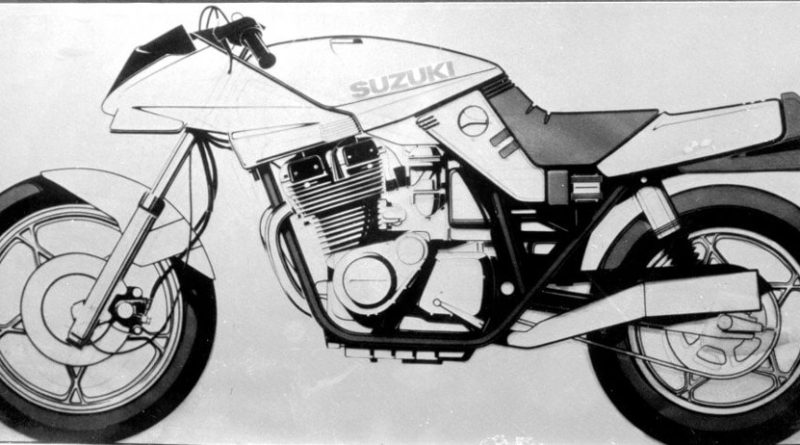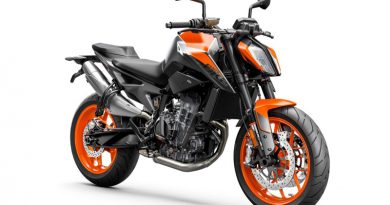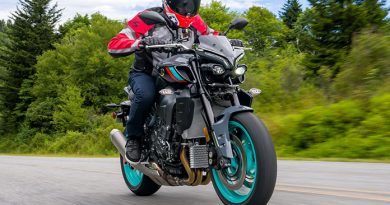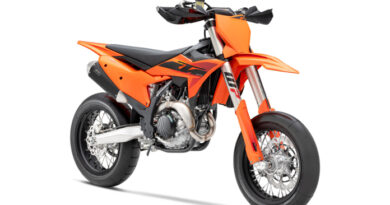The Suzuki GSX1100S Katana – Letting the Kat out of the Bag
The year is 1980. The big four Japanese motorcycle manufacturers all think their model inventory for the start of the new decade is pretty bodacious.
This moment in history was the era of the Honda CBX-6, Yamaha Midnight Specials, and the fuel-injected Kawasaki Z1000H. Even Suzuki upped the performance stakes with the launch of the 16-valve GSX series.
Beavering away behind the scenes, one manufacturer was concealing a secret project. A project so secretive, they hired a small German design team, thus becoming the first Japanese motorcycle not designed in-house.
The three young guys who made up Target Design in Bavaria were in business for just one year when they landed the prestigious gig. But, what they lacked in quantity, they more than made up for in quality.
The manufacturer was Suzuki. And the motorcycle that Target Design delivered was the Katana. The Katana’s styling was so radical, the sound of jaws hitting the floor reverberated around the motorcycle world.
Early Suzuki Katana concept drawing. Photo: Target Design
Suzuki Katana Concept drawing by Target Design. Photo: Target Design
Suzuki’s brief was simple. “We want a European type design.” These instructions may appear rather bland or even vague, but it was fueled by a specific problem.
As early as 1975, the American motorcycle press coined the phrase Universal Japanese Motorcycle (UJM) to describe the look-alike 4-cylinder bikes on the market. Suzuki wanted to break the mold and thanks to Target, they achieved it in spades.
Go Big or go Home
The first motorcycle to receive the Katana styling was the reliable but bland GS650, code-named ED1. Then, in October 1979, Target presented the initial designs to Suzuki. They, to everyone’s surprise, picked up the ball and ran, albeit with one notable exception.
Someone in the Suzuki top brass was an early adopter of the “go big or go home” philosophy. So the ED2 project got the green light, but with a warmed-up version of the recent GSX1100 engine as its heart.
Early Suzuki Katana concept drawing. Photo: Target Design
Over the winter months, Target Design worked on a clay mock-up, and by April 1980, a working prototype was ready. When revealed at the Cologne Motorcycle Show the same year, the motorcycle press believed the Katana so radical it would never be more than a concept.
A few short months later, with only minor tweaks, the first GSX1100S Katana rolled off the production line. The Katana was now out of the bag.
The first Suzuki Katana. Photo: Target Design
Why was the Katana so Important?
The Katana represented a paradigm shift away from traditional motorcycle design concepts. Let’s take the 1980 6-cylinder Honda CBX1000 as an example. Consider as groundbreaking as it was, the emphasis was on displaying the engine.
The relationship between tank, seat, and mudguard barely moved away from the horizontal. This layout had been around for decades.
Target Design threw away the design rulebook, creating a wedge-shaped gas tank that transitioned into a small but significant angular nose fairing. Even the seat came in for special attention, using contouring and contrasting finishes on the front and back to create an added feeling of movement.
Suzuki’s brief was minimal. However, they made it clear that even though the bike’s looks could be revolutionary, it had to adhere to current production processes.
In other words, no costly re-tooling or race-shop assembly (like the early Honda Africa Twins) to slow things down and drive up costs.
Having previous experience with the likes of BMW and Porsche, Target Design was well aware of the design riders imposed by the production process. So they moved the gas cap to one side to allow for the welding of the two halves of the tank and created the rigidly mounted body panels in such a way as to make them easier to produce.
The result was a perfect blend of dramatic concepts backed by production-friendly components. To say that Target Design nailed it and that Suzuki got their money’s worth would be an understatement.
The combination of dramatic, angular shapes gave an overall aesthetic of rapid forward movement even when stationary. In other words, it looked like it was doing a ton while standing still.
Here’s a screengrab from YouTuber adikxx83 showing the Suzuki Katana riding position. Photo: YouTube: adikxx83
Riding Position and Weight Distribution
With Target Design’s lead designer, Hans-George Kasten, a keen biker, the team paid a lot of attention to the riding position and weight distribution. For the first time, the rider sat in the motorcycle rather than on it, and the language of motorcycle design changed overnight.
There was, of course, a price to pay for such a radical design. At 535-lbs with a tank full of gas, the Suzuki 1100 Katana was visually and physically imposing, and the riding position stretched the rider. The rider was forced into an elongated racing crouch from the high, set back footrests to the low seat and clip-on handlebars.
Although the motorcycle press of the era made a point of highlighting the uncomfortable seating arrangement, you have to remember; this was 1980. Apart from the Ducati 900SS, mass-produced sports bikes were unknown.
Giving the Kat some Claws
There was no getting away from the riding position and heavy front end, which combined, made riding slowly through traffic difficult. Yet no one could deny, give the big Kat a handful through the curves, and the riding position and weight distribution at once made total sense.
As racing legend Jack Brabham once said, “when the flag drops, the bullshit stops,” and with Suzuki’s reputation for speed, they gave the Kat claws.
Taking their recently introduced muscle-bound 16-valve GSX1100, the engine came in for some modest yet effective tweaks. The induction system was the first to get an upgrade with a reworked airbox and tuned carbs. A new, more aggressive outlet camshaft got added, and the alternator lightened.
Suzuki’s main aim of increasing power while maintaining flexibility and reliability became a reality. Better yet, the minor adjustments added an extra 11-bhp taking the total to 111-bhp at 8500rpm.
The already responsive GSX1100 engine now gave immediate pickup. A good dose of right hand made the Katana fly through its seemingly endless mid-range, right through to an urgent top-end shove.
In its first production year, Suzuki advertised the Katana as the fastest mass-produced motorcycle on the street. Even mighty juggernauts such as the Honda CBX1000 (105-bhp-136-mph) and Kawasaki Z1000 MkII (94-bhp 131-mph) couldn’t come close.
Suzuki Katana GSX 1100S advertisement. Photo: MCN AU
The GSX1100S Katana roared through the timing lights at a breathtaking 140-mph, silencing any opposition that this motorcycle was all show and no go.
Pushing the Envelope
Apart from its addictive acceleration, the Katana scored in one other department. For quite some time, Japanese manufacturers concentrated on the technical innovation and performance of their engines.
As long as the handling wasn’t too bad, upgrades were left for owners to sort out with aftermarket accessories such as braced swinging-arms and steering dampers.
Once again, this is where the groundbreaking Katana pushed the envelope still further. The standard GSX 1100 ET twin cradle steel frame came into play for ease of cost and production, but re-drilled triple clamps achieved the increased steering angle.
Sport orientated twin rear shocks with 5-way adjustability kept the rear end taut, while Suzuki treated the front forks to some racetrack technology. The anti-dive units fitted to the forks, like the riding position, came in for heavy criticism. This time though, justifiable.
Allegedly borrowed from Suzuki two-stroke race bikes, the hydraulic anti-dive units at the bottom of each fork leg of the Katana proved to be its Achilles heel. As a result, under heavy braking, the front forks would become overdamped, causing the wheel to skip and lose traction.
When Katana’s took part in production racing championships in the early 1980s, the first modification privateers made was to disable the ‘race-bred’ anti-dive units.
One of the Suzuki Katana Race Bike. Photo: Wes Cooley Collection
Anti-dive units aside, as a result of the Katana’s geometry, rider ergonomics, and extensive wind tunnel testing, the bike was incredibly stable even at 140-mph.
Once again, you cannot overstress the importance of this stability. Most large bore motorcycles of the day, including Yamaha’s XS1100 and the sporty Kawasaki Z1-R, displayed significant weaving at high speed.
Reaction on the Street
Initial sales figures were hardly earth-shattering, and the Katana’s futuristic looks got the blame. It would seem that the press’s reaction at the bike’s launch in Cologne held. It was just too radical for mass consumption.
Regardless of this fact, readers of the UK’s largest motorcycle newspaper, Motorcycle News, in 1981 voted the Katana its ‘Motorcycle of the Year.’
Those bold enough to shell out the 2900GBP for entry into the Kat club had the ride of a lifetime. Nothing on the road could touch this motorcycle in a flat-out drag. What’s more, and if that wasn’t enough, they could also walk all over the opposition through the bends.
Though, best of all were those space-age looks. They either jettisoned the onlooker in the opposite direction or sucked them in like the gravitational pull of a black hole.
Other Katana Models
If the biggest and baddest of the bunch was too much to live with, then other models lower in the range also bore the red sword and Katana logo. If you recall, the basis of project ED1 was the shaft-driven Suzuki 650, which turned into the GS650G Katana.
The GS550M Katana joined this bike shortly afterward. Both the 650 and 550 models followed the same styling cues but without the more extreme riding stance and bodywork.
It was only the GSX750S that received the full Kat treatment. However, production of this model was for the Japanese market only and was identifiable by its pop-up headlight.
In 1983, Suzuki rolled out the ultra-rare XN85, a 700cc turbocharged Katana. In production for only one year, you’ll probably never see one this side of a classic motorcycle show.
Here’s a walk-around video and start-up of the famous Suzuki Katana XN85 Turbo
By 1985, this exciting chapter in Suzuki history ended with the Katana range pulled from sale in Europe.
Like all good stories, though, the tale of the Katana doesn’t end there. In 1990 Suzuki dusted off the original tooling to produce a limited run of 200 GSX1100S’. Everyone got snapped up immediately, so they did the same the following year and added replica 250 and 400 versions to the mix.
Once again, aimed purely at the home market, few made it to Europe as grey imports, and by 2001 every size of Katana was phased out.
Almost a decade later, realizing that retro was back with a vengeance, Suzuki attempted to re-live the whole Katana episode. The high-tech 2020 GSX-S 1000 Katana got handed over to an out-of-house design team. Even though the modern version mirrors the original and is far lighter, faster, and handles better, that elusive X-factor just isn’t there.
Suzuki GSX & XN Launch Year and Features
Model
Year
Features
ED2 GSX1100S
1980
GSX1100S Katana sends shock waves throughout the motorcycle world
ED1 GSX650G
1981
The original Katana design finally launches as a 650cc shaft drive
GSX550M
1981
Smallest Kat for the European market features 550-4 engine and chain drive
GSX750S
1982
750cc Kat features trademark bodywork and pop up headlight- Japanese market only
XN85 Turbo
1983
700cc turbo and first production bike to feature a 16” front wheel and Suzuki’s full floater suspension- only 1,153 made
Living with a Suzuki Katana
As mentioned earlier, the riding position for a 1980 motorcycle was radical, but by today’s standards, it’s pretty tame. The cable-operated clutch and throttle are light for an everyday ride, and the original triple-disc brakes benefit from modern brake pads and steel hoses.
By now, the dodgy anti-dive forks are either scrapped or modified. So, all things considered, an original Suzuki GSX1100S Katana will still make a decent daily ride or a brilliant weekend blaster.
Suzuki Katana GSX 1100S Prices
With the original big Kat in production from 1981-1985, stocks of used examples aren’t thick on the ground. Although restored versions are collectible, prices for a decent example come in at around $14,000 (11,700EUR).
1981 Suzuki GSX 1100 S Katana for $14,709. Screenshot: Grays.com
Lock onto one of the ultra-rare 1000-cc wire wheel models, built for production racing homologation, and you could be looking at $40,000+ (35,000EUR+). A mere 200 of this hot cam, Mikuni carb variant, were built and are the Holy Grail of Katanas.
On the flip side, if you want the Katana vibe on a budget, you can still find the 550 and 650 for less than $4000 (3500EUR), while a good 750 will hover around $6700 (5830EUR).
Some riders interested in bikes such as the early ’80s 1100 Katana want an immaculate nut and bolt restoration to add to their collection. Big Kats should not be in a cage though, and this is one motorcycle that is still capable of being enjoyed to the max. So do yourself a favor and let the Kat out of the bag.
The Ultimate Buyer’s Guide For Motorcycle Gear:
Best Motorcycle Backpacks
Coolest Motorcycle Aviator Goggles
Motorcycle Ankle Boots
GUIDE: Gear For A Motorcycle Roadtrip
Top-10 Retro Motorcycle Gloves
Best Black Leather Jackets
Carbon Fiber Open Face Helmets
The post The Suzuki GSX1100S Katana – Letting the Kat out of the Bag appeared first on Old News Club.




